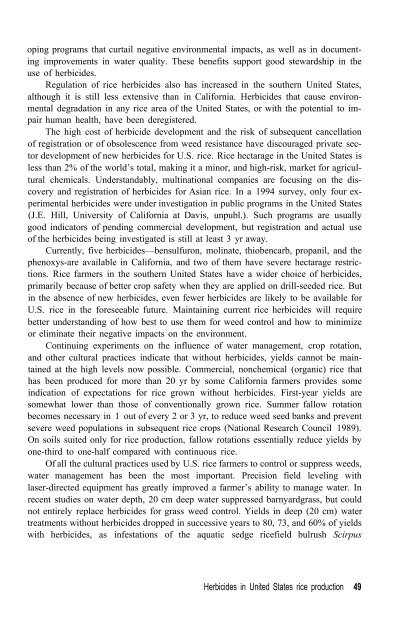HERBICIDES in Asian rice - IRRI books - International Rice ...
HERBICIDES in Asian rice - IRRI books - International Rice ...
HERBICIDES in Asian rice - IRRI books - International Rice ...
Create successful ePaper yourself
Turn your PDF publications into a flip-book with our unique Google optimized e-Paper software.
op<strong>in</strong>g programs that curtail negative environmental impacts, as well as <strong>in</strong> document<strong>in</strong>g<br />
improvements <strong>in</strong> water quality. These benefits support good stewardship <strong>in</strong> the<br />
use of herbicides.<br />
Regulation of <strong>rice</strong> herbicides also has <strong>in</strong>creased <strong>in</strong> the southern United States,<br />
although it is still less extensive than <strong>in</strong> California. Herbicides that cause environmental<br />
degradation <strong>in</strong> any <strong>rice</strong> area of the United States, or with the potential to impair<br />
human health, have been deregistered.<br />
The high cost of herbicide development and the risk of subsequent cancellation<br />
of registration or of obsolescence from weed resistance have discouraged private sector<br />
development of new herbicides for U.S. <strong>rice</strong>. <strong>Rice</strong> hectarage <strong>in</strong> the United States is<br />
less than 2% of the world’s total, mak<strong>in</strong>g it a m<strong>in</strong>or, and high-risk, market for agricultural<br />
chemicals. Understandably, mult<strong>in</strong>ational companies are focus<strong>in</strong>g on the discovery<br />
and registration of herbicides for <strong>Asian</strong> <strong>rice</strong>. In a 1994 survey, only four experimental<br />
herbicides were under <strong>in</strong>vestigation <strong>in</strong> public programs <strong>in</strong> the United States<br />
(J.E. Hill, University of California at Davis, unpubl.). Such programs are usually<br />
good <strong>in</strong>dicators of pend<strong>in</strong>g commercial development, but registration and actual use<br />
of the herbicides be<strong>in</strong>g <strong>in</strong>vestigated is still at least 3 yr away.<br />
Currently, five herbicides—bensulfuron, mol<strong>in</strong>ate, thiobencarb, propanil, and the<br />
phenoxys-are available <strong>in</strong> California, and two of them have severe hectarage restrictions.<br />
<strong>Rice</strong> farmers <strong>in</strong> the southern United States have a wider choice of herbicides,<br />
primarily because of better crop safety when they are applied on drill-seeded <strong>rice</strong>. But<br />
<strong>in</strong> the absence of new herbicides, even fewer herbicides are likely to be available for<br />
U.S. <strong>rice</strong> <strong>in</strong> the foreseeable future. Ma<strong>in</strong>ta<strong>in</strong><strong>in</strong>g current <strong>rice</strong> herbicides will require<br />
better understand<strong>in</strong>g of how best to use them for weed control and how to m<strong>in</strong>imize<br />
or elim<strong>in</strong>ate their negative impacts on the environment.<br />
Cont<strong>in</strong>u<strong>in</strong>g experiments on the <strong>in</strong>fluence of water management, crop rotation,<br />
and other cultural practices <strong>in</strong>dicate that without herbicides, yields cannot be ma<strong>in</strong>ta<strong>in</strong>ed<br />
at the high levels now possible. Commercial, nonchemical (organic) <strong>rice</strong> that<br />
has been produced for more than 20 yr by some California farmers provides some<br />
<strong>in</strong>dication of expectations for <strong>rice</strong> grown without herbicides. First-year yields are<br />
somewhat lower than those of conventionally grown <strong>rice</strong>. Summer fallow rotation<br />
becomes necessary <strong>in</strong> 1 out of every 2 or 3 yr, to reduce weed seed banks and prevent<br />
severe weed populations <strong>in</strong> subsequent <strong>rice</strong> crops (National Research Council 1989).<br />
On soils suited only for <strong>rice</strong> production, fallow rotations essentially reduce yields by<br />
one-third to one-half compared with cont<strong>in</strong>uous <strong>rice</strong>.<br />
Of all the cultural practices used by U.S. <strong>rice</strong> farmers to control or suppress weeds,<br />
water management has been the most important. Precision field level<strong>in</strong>g with<br />
laser-directed equipment has greatly improved a farmer’s ability to manage water. In<br />
recent studies on water depth, 20 cm deep water suppressed barnyardgrass, but could<br />
not entirely replace herbicides for grass weed control. Yields <strong>in</strong> deep (20 cm) water<br />
treatments without herbicides dropped <strong>in</strong> successive years to 80, 73, and 60% of yields<br />
with herbicides, as <strong>in</strong>festations of the aquatic sedge <strong>rice</strong>field bulrush Scirpus<br />
Herbicides <strong>in</strong> United States <strong>rice</strong> production 49

















